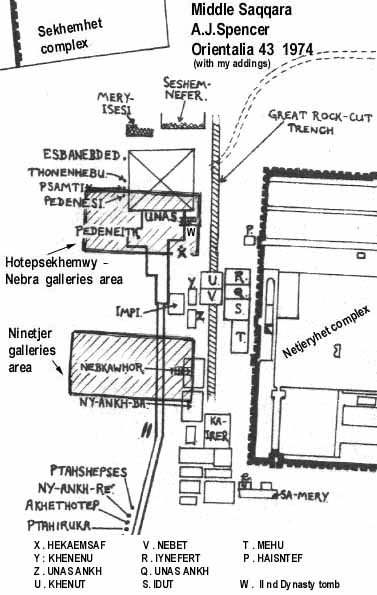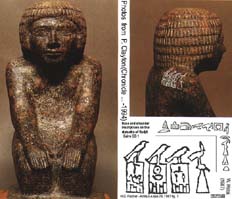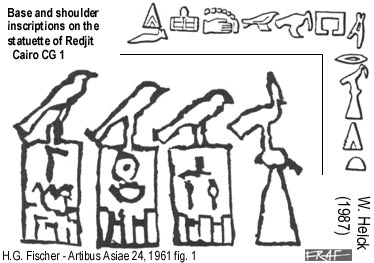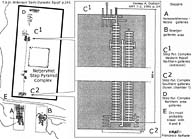-
Although the Second Dynasty is reported to have been -as the First Dynasty- of Thinite origin (by Manetho), most of its kings are better attested in the Saqqara necropolis than at Abydos.
When A. Barsanti found (1901-2) the galleries under the Unas pyramid complex at Saqqara, the only known IInd Dynasty kings were those named on the Umm el Qaab seal impressions and stone vessels inscriptions (found in those years in large number by Amelineau and then by Petrie) and the two owners of tombs P and V in the same Abydos necropolis.
Later, with the discoveries at Saqqara in the first half of the XXth century, the sources became more numerous in the northern cemetery thanks to the finds of North Saqqara mastabas and especially for the immense quantity of stone vessels from Netjerykhet/Djoser funerary complex (originally more than 40.000 vases, with some hundreds inscriptions; cf. Firth - Quibell, Step Pyramid, 1935, 119ff., pl. 88-91, 96-107; Lauer, Pyr. Deg. III,1939).
Only the last two rulers of the dynasty still remain better known for their Upper Egyptian archaeological evidence than for the northern meagre attestations.Hotepsekhemwy is considered the founder of the Second Dynasty; even if some of Manetho's dynastic breaks do seem groundless (cf. F. Raffaele, BASADE 1, 2003), that's not the case: Hotepsekhemwy probably buried Horus Qa'a but the possibility that at least two kings ruled between them (Seneferka and Bird, known from Djoser's complex stone vessels inscriptions and S3505 vessels and a sealing), has been advanced by some scholars (N. Swelim , P. Kaplony , W. Helck); the epigraphic contents of the inscriptions (espec. the funerary domain name, Hwt Za-Ha-Neb and the Qaw-Netjerw "Götterfestung") fits better with a collocations of these ephemeral sovereigns between the first and the second dynasty than in the second. Discovered in the Memphite necropolis, these kings appear of Lower Egyptian origin; yet they must have held the throne for a very short period, and in the case of Sneferka this could have been a queen's name (see my page). On the other hand the seal impressions of Hotepsekhemwy found on the entrance of Abydos Umm el-Qaab Q (Qa'a) and, possibly, the Sehetep-Nebty prince name (?) on some labels from the last years of Qaa's reign (cf. labels corpus nr. 9 and nr. 19) could have indicated that Hotepsekhemwy was a (young?) successor of the last legitimate king of the First Dynasty. This latter's heir Sen-Nebty [*] would die before the c. 35 years reign of Qaa came to an end, thus creating some problems to the succession of Shotep-Nebty (s-Hotep is the causative verbal form of Htp: this name Shotep-Nebty is quite similar to Hotepsekhemwy's personal name Hotep-Nebty known on many inscriptions: cf. here, below).
Finally the reasons for a markedly propagandistic name as 'the two powers are in peace', would find a chronologically and geographically closer reason to be if we hypothesize any political disruption or royal family troubles at the court of Qaa, rather than in earlier reigns (i.e. Semerkhet).
*[Note that Sen-Neby and Shotep-Nebty are generally interpreted as two successive Nebty names of Horus Qaa; however the question might be differently explained and I myself had begun to doubt about these "Nebty titles" especially when the name appears without Nswt-bity. For the problem of Nebty as a recurring infix of prince's names and the question of Horus Adjib and his followers' royal titles you can now read the important contribute of P. Kaplony, "Er ist ein Liebling der Frauen". Ein "neuer" König und eine neue Theorie zu den Kronprinzen sowie zu den Staatsgöttinnen (Kronengöttinnen) der 1./2. Dynastie, Ägypten und Levante 13, 2004, 107-126].
- Names
The Horus Name (Hotepsekhemwy) was the royal titulary most important name in this period; it was received at the accession.His birth name was Hotep-Nebty (or Sehotep-Nebty, cf. above). Probably Nebty was still an infix in the name, rather than a royal title [later in the OK it will be used in princesses' names, as Sekhemkhet's Djesertj-Nebty (Ankh) on a textiles-list label from Saqqara or the Elephantine late Third Dynasty ink inscribed vessels with the name of a wrt-Hts Djefat-Nebty].Manetho states that during the 38 years reign of Boethos a chasm opened at Bubastis and many perished . Boethos (Africanus) and Bochos (Eusebius) are taken as misinterpretations of the name Bedjaw (Abydos king list , 9th name) and the same name Bedjaw is in turn likely an earlier misinterpretation of the real name Hotep (owing to hieratic sign similarities).A 43 columns inscription from Mastaba G 1011 (Giza, writing board) was brought in the Cairo Museum by Reisner at the beginning of '900; it named Bedjaw and other later Old Kingdom kings (Wildung 'Die Rolle Agyptischer konige...' 1969 p. 39 tav. 2,3).Baw-netjer is the name attested both on the Turin Papyrus (2.20) and on the Saqqara list (3rd name). It has never been found on monuments or on contemporary inscriptions.Given the very probable Memphite origin of the Turin Papyrus and of the Saqqara Tjuloy tomb king-list, I think that the name Bawnetjer could perhaps refer to one of the ephemeral kings whose scarce traces have been found at Saqqara and who have been placed in a chronological frame between Qa'a and Hotepsekhemwy (cf. above); one of these rulers' name is written with a bird sign which could have been (mis-?) interpreted as Ba (yet to be distinguished from a possible Horus Ba of the Third Dynasty): this could be the individual whose birth-name has been handed down by the cited sources as Bawnetjer. [Also note that the signs in the serekhs of a seal impression from S3505 = IAF 742 and on a Saqqara stone vase (Pyr. Deg. IV, nr. 97) might both represent a bird: cf. the ruler names *Sekhet in my page of Sneferka].If this theory was correct Kakaw could be applied to Hotepsekhemwy and no mention would be made for Nebra; but this is quite a hypothesis and it has no more probabilities to be true than the common one which links Bawneterw to Hotep-Nebty.The Horus name "Hotepsekhemui" has an evident similitude with that of Khasekhemwy, last ruler of the same dynasty.Although in much minor scale than with Khasekhemui, Hotepsekhemwy's name has also been regarded as part of a programmatical intent to declare the re-union of the Upper and Lower Egypt, or, more likely, aiming to definitively seal the succession after the turmoils of his father's reign conclusion. - The findings
- Sealings
Recent German excavations on the Umm el Qaab have yielded a seal-impression from nearby the entrance of the tomb of Qa'a (Q) (Dreyer et al., in: MDAIK 52,1996, 71-72, fig. 25, pl. 14a); this has been taken as a proof of the presence of Hotepsekhemwy at the funerary ceremony of the Horus Qa'a, thus a clue in favour of "keinen Bruch zwischen 1. und 2. Dynastie".Other seal impressions were found by A.Barsanti in the western one of the two Saqqara tombs south of the Netjeryhet complex, under the pyramid of Unas (A.S.A.E. 2, p. 249-57 and A.S.A.E. 3, p. 182-90; Kaplony I.A.F. 3 fig. 262,263,281,282,307) and it was these objects to have dated the galleries complex to the reign of Hotepsekhemwy (see below).The Royal estate of Hotepsekhemwy is attested on the seals with the name 'Hwt Nswt-Bity Nebty HTP'.The King's domain is called 'Hor Kha (m) sba' (Horus rises as a star) [P. Kaplony, IAF III, 150-151; W. Helck, Untersuchungen zur Thinitenzeit, 1984, 194-195; E.M. Engel, in: Czerny, Hein et al. (eds.), Timelines... Studies in Honour of M. Bietak, vol. 2, 25-34].The mentioned Qa'a tomb seal impression names the famous Buto Royal Palace 'Hwt Pe Hor Mesen' (or 'Hwt Pe Hor Way') which had been built in the first dynasty and was still active during the Third (T. Wilkinson E.D.E., 1999, 119-20 and above all P. Kaplony, IAF I, 1963, 150ff.).
Other objectsThe most famous object bearing this king's name is the statuette of a kneeling priest (Cairo C.G.1) once called Hotepdief and now more probabily identifiable as Redjit . The material is pink granite, the provenance Memphis (Mit Rahina). The base has an inscription (Helck, Thinitenzeit, 1987, 240) relating to the 'Chief of the incensers, who makes an offering, beloved by Ntr-Akhty, Redjit'; the god Netjer Akhety is a phoenix atop a stand or perch; this could also have relationship with the city of Buto; fragments of stone vessels have the names of Hotepsekhemwy and Nebra associated with Bastet the goddess of Per Bast (Bubastis) or 'She of the ointment jar' (Wilkinson E.D.E. p. 282); the bird on the top of a conical object appears also on the same statuette' s shoulder before the Horus names of the first three kings of the second dynasty. (Redjit inscriptions) (Wildung suggests to interpret the bird hieroglyph in question as the god Dbawty). Redjit was therefore a funerary priest of these three kings' cult in the Memphite necropolis during the mid or late 2nd dynasty (see also H.G. Fischer, in: Artibus Asiae 24, 1961, 46, fig.1; D. Wildung, Die Rolle..., 1969, 36-40). This latter author, and more recently M. Eaton-Krauss and H. Sourouzian (both in: Grimal ed., Les Criters de datation stilistiques... 1998) date the statuette to the late Third Dynasty for the unusual location of the inscription on the shoulder and especially on the base of the circular headdress which in similarto that of the statue of Metjen.
A bone cylinder perhaps from Helwan is at the Brooklyn Museum (Needler 1984, p.379) and might be part of a furniture. It displays the serekh of Hotepsekhemwy in simplified but sharp drawing.The king in question is known at Abydos by 4 stone bowls fragmentary inscriptions found by Petrie in the Umm el Qaab tomb P (Peribsen) and one found in the tomb V (Khasekhemwy) at the same site. (Tomb P : Petrie R.T. II tav. 8,8 - 8,11; tomb V : Kahl, Das System, 1994, Quelle 2047; Amelineau, N.F. II, 1902, pl. 21,6). Two of these inscriptions refer to the possible Ka-House (Hwt Ka) of Hotepsekhemwy; the piece in tav. 8,11 names the god Akhty which has lead Helck (cit. above) to read Ntjer-Akhty the two bird figures on the Cairo C.G.1 statuette of Redjit.
More than twenty inscribed fragments of stone vessels from the Step pyramid complex are dated to Hotepsekhemwy (Lacau-Lauer, PD IV.1, 1959, pl. 10-12, 15, 17, nr.79-83; PD IV.2, 1961, 29-32, 39-40; Kahl, op. cit., 310-11).Other inscriptions on Stone vessels from private collections are in Kaplony Z.A.S.88,1962, fig. 5, 8, 9 and id., MDAIK 20, 1965, fig. 48, 49. They mention this king's Memphite and Butish palaces, the Bastet foundation, the Upper and Lower Egypt crowning-temple, the Hwt-Ka of Hotepsekhemwy and the Hwt-Ka of Netjer Akhety, the Hwt 'Za-ha-ka' and 'iz mehyt'. (cfr. also Helck, in: ZAS 106, 1979, 122; id., Thinitenzeit, 117, 124, 194-5,204,217). (Stone Vessels inscript. fig.2)Two inscribed stone bowls of Hotepsekhemwy were found by Reisner in Menkaura' s pyramid complex at Giza .An alabaster vessel fragment also bearing his serekh has been found by Brunton in the grave 3112 of Badari.Lastly few other unprovenanced pieces (among which a black granite cup) have this king's name on them (Kahl cit. p. 312).
Some of the inscriptions on stone vessels were engraved on older ones. The sherd BM 35556 (cf. Spencer, Catalogue, 1980, 42, nr. 275 = Petrie RT II, pl. 8.12; good photo in: Donadoni Roveri - Tiradritti eds., Kemet. Alle Sorgenti del Tempo, 1998, 251; see also Kahl, 2007) might have been reused for two kings (not including Nebra, whose name appears in the Hwt-Ka rectangle on the right) and in my opinion Nswtbity Htp(-Nebty) was the first name engraved on it (the htp sign can be detected underneath the nTr hieroglyph of Njnetjer's name).
J. Kahl (in: »Ra is my Lord«. Searching for the Rise of the Sun God at the Dawn of Egyptian History, Wiesbaden, 2007, 12) proposes instead that Ninetjer erased Wneg's name, therefore the latter one was Nebra's Nswtbity Nebty name. He doesn't see any other late 1st Dyn. or Early 2nd Dyn. Horus name on that vessel shard.
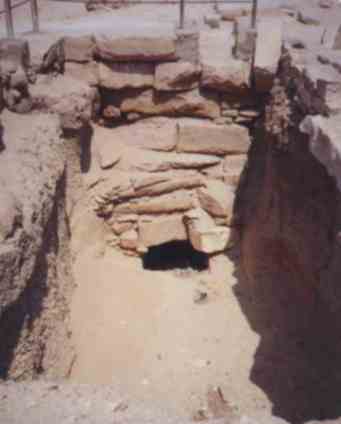
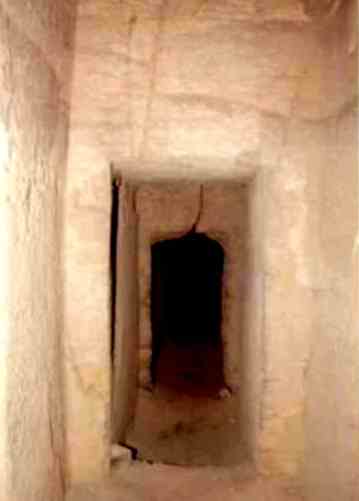
- Tomb A
_________________(High res jpg)________________(Low res gif)__________________________ -
- Substructure
*[These latter, after S. Hassan's explorations early in 1950s have been only recently re-explored: but it is hoped that new researches will be carried out in these large early Second Dynasty tombs (A and B) which, despite their poor state of preservation and structural instability, must certainly still hide many more remains than the later and smaller royal tombs do (namely tomb C and D, which were also reused, but for 18th Dynasty important personages burials, thus being subject to more systematical and complete clearing and rebuilding programs than tombs B and and A, cf. below)].
The labyrinthic extension of tomb A is likely to imitate the corridors of the royal abode, giving an interesting clue of the early royal palaces layout.
Superstructure
Yet the major proof for the attribution of the galleries complex to Hotepsekhemwy still remains his apparently longer regnal period, which would seem to fit better with the construction of this large tomb, the first one in the new Memphite royal cemetery.
Lastly we must mention the dry moat or trench (cfr both the plans infra) running west-east parallel to the Djoser' s temenos and to the Unas causeway: it could be natural (DE 26 with photos; Orientalia 62, 1993, 381) and in this case it surely was a relevant factor in the placing of the two Second Dynasty tombs A and B. On the other hand N. Swelim (in: J. Baines ed. 'Pyramid Studies and other Essays ... to I.E.S. Edwards', 1988, 12-22) convincingly describes the relationship between the dry moat and Netjerykhet Step Pyramid Complex. In this case the early Third Dynasty king must have used this topographical feature as a further barrier to "protect" his huge monument. Only more careful archaeological investigations will make us capable to comprehend the extent and constructional modalities of the 2nd Dynasty royal cemetery at Middle Saqqara.
It is already clear that it developed from North to South (middle dynasty ephemeral rulers' tombs are placed in the area of the Maya, Meryra, Horemheb New Kingdom cemetery; cf. J. Van Wetering, in press) but a certain pattern of the initial obliteration of the royal tombs superstructures hasn't been yet identified. We must thus remain cautious in the attribution of the razing of these structures to the period of Unas: instead, strange as it might seem, it could have commenced already by the time of Djoser.
Conclusions
The reign of Hotepsekhemui is not as rich of archaeological findings as that of Ninetjer, his second successor; nonetheless it evidences some sensible change tendencies, expecially in the administrative and funerary architecture subsystems, that must have depended on rapid transformations occurred in other contexts of the state organism.
The name question has been already dealt with above; someone has suggested that this king reunified the country after a civil war which had divided the two lands. Something similar has been thought to happen once again a century after (Peribsen). These are remains of an old way of interpreting data and reconstruc history.
Hotepsekhemwy decided to build his funerary complex in the Memphite necropolis after it had been at Abydos for at least 200 years.
It's probable that, owing to the large lapse of time involved, we are missing a whole stage in the chain of development of royal complex superstructure; their total effacement hinders precise reconstructions, but a parallel with the contemporary North Saqqara private mastabas (as S2302) suggests that the monumental aspect cannot have been disregarded.
Year-labels, an important device produced by the administration of the First Dynasty from the reign of Narmer to Qa'a 's, suddenly disappear from the tomb equipment; they simply cease to exist, substituted in their function by other means. Another hint at the deep changes in the state administration and control, as also the count of time was: it was certainly from the reign of Hotepsekhemwy that cattle- (and other riches) counts started to be used as the main calendaric reference (which was shortly taken over during the Third Dynasty and definitively readopded from Snofru's reign on).
Helck (Thinitenzeit, 124) supposed a total of c. 39 years for the reigns of Hotepsekhemwy plus Nebra, according to the space they should have occupied on the Annals (on the right hand and likely at the beginning of line IV on the original slab).
Selected Bibliography
A. Barsanti, ASAE 2, 249-57; id., ASAE 3, 182-4; G. Maspero, ASAE 3, 185-90; P. Munro, in: GM 63, 1983, 109; Munro et al., DE 26, 47ff.; J.P. Lauer, MDAIK 15, 160-1; id., BIFAO 79, 363-65; D. Jeffryes - A. Tavares, MDAIK 50, 150; H.G. Fischer, Artibus Asiae 24, 45-8; A.M. Roth, JARCE 30, 1993, 40, 43-44; R. Stadelmann, BdE 97/2, 1985, 295-307; J.P. Lauer, Hist. Monum., 56-8, pl. 6a; id., Pyr. Deg. I, 4, fig.2; W. Kaiser, in: Gegengabe...FS Brunner Traut, 1992, 167-90; A.M. Dodson, The Mysterious Second Dynasty, in: KMT 7:2, 1986, 19-31; also cf. the excavations reports in Orientalia 57, 62, 63 (pages cit. in the text).
